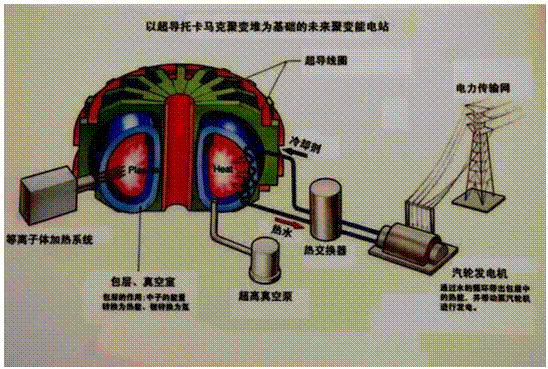Fusion is a process in which light nuclei (mainly including deuterium and tritium isotopes of hydrogen) are heated to hundreds of millions of degrees centigrade to form more massive nuclei with the simultaneous release of energy, this is exactly the principle for the lighting and the heating of the Sun and the explosion of hydrogen bombs. Features of fusion energy are: first, fusion reaction releases a large amount of energy—deuterium in a liter of seawater can release, via fusion reaction, equivalent energy from the burning of 300 liters of gasoline; second, fusion resource reserves are abundant—if used in D-T fusion reaction, deuterium contained in seawater on Earth can be available for supply for hundreds of millions of years, and the abundant reserves of lithium used for generating tritium can also be used in fusion reaction for tens of thousands of years; third, the product of fusion reaction is helium, relatively stable and non-radioactive. In view of the intrinsic safety of fusion energy, the superiority of environment and the richness of fuel resources, fusion energy is regarded as the most ideal clean energy of mankind.

Schematic Diagram of Fusion Reaction
The explosion of hydrogen bombs opened the/a new horizon for the R&D of fusion reaction/energy. Under the high temperature and high pressure formed by the explosion of atomic bomb, fusion reaction of thermonuclear fuels deuterium and tritium takes place to release enormous energy and form formidable destructive power. But the instantaneous violent explosion of hydrogen bomb is uncontrollable. To use the huge energy released from fusion in social production and human life, we must exercise control over the drastic fusion reaction. Therefore, controlled thermonuclear fusion has been always a dream of fusion scientists.
Controlled thermonuclear fusion requests two harsh conditions:
First, extremely high temperature
For their fusion reaction, two atomic nuclei must stay close enough until the working distance of the nuclear force between their nucleons; only at the moment can the nuclear force “bonds†them into a new atomic nucleus. Because atomic nuclei are all positive, the electrostatic repulsion of two atomic nuclei will keep growing when they move closer with each other. Electrostatic repulsion, also known as electrostatic potential, is like a mountain that separates the two deuterons. According to estimates based on experimental data, two deuterons won’t meet unless their relative speed is bigger than 1,000 kilometers per second. At this point, a single deuteron has tremendous kinetic energy, and is at an extremely high temperature compared to a lump of deuterons as a whole. When two deuterons enter into fusion reaction, the temperature must be hundreds of millions of degrees centigrade. When a deuteron and a triton enter into fusion reaction, the temperature also must be above one hundred million degrees centigrade. The fusion reaction that won’t take place until under an extremely high temperature is also known as thermonuclear reaction. At such a high temperature, substances will have been all ionized to form high-temperature plasmas. To exploit and utilize fusion reaction energy, a lump of plasmas as high as hundreds of millions of degrees centigrade must be generated at first.
Second, sufficient confinement
Sufficient confinement means maintaining the high-temperature plasmas for a relatively long time so that fusion reaction will take place fully to release enough energy, more than the energy needed to generate and heat plasmas and the loss of energy in the process. In this way, the necessary extremely high temperature can be maintained using the energy released from fusion reaction, and the fusion reaction can be self-sustaining without absorbing energy from outside. This concept is expressed with the scientific term of “fusion ignitionâ€. It won’t be realized unless for a certain confinement time. Confinement time is associated with density. If the density is big, more atomic nuclei will take part in reaction and more energy will be given off in unit time and hence, a shorter confinement time is requested. Otherwise, the confinement time must be longer. According to the British scientist Lawson’s detailed study on the necessary condition of fusion ignition (ignition condition is also called Lawson condition or Lawson criterion) in the 1950s, it is the function of the product of temperature T, confinement time t and density n.
To enable “ignition†is merely the first step of controlled fusion reaction research. The second goal is to output more energy than the energy input and obtain net fusion energy. Scientists regard the first goal, enabling “ignitionâ€, as verifying scientific feasibility and the second goal as verifying technical feasibility.
Presently, major controlled nuclear fusion methods include: magnetic confinement fusion (tokamak), laser confinement (inertial confinement) fusion and ultrasonic wave fusion. In specific, magnetic confinement enables fusion reaction by using high-intensity magnetic field to confine charged particles, structuring reaction chambers, building up fusion reactors and heating fusion materials to hundreds of millions of degrees centigrade. “Tokamak†magnetic field confinement enables the nuclear fusion by confining plasmas in a very small scope using the high-intensity magnetic field generated from heavy currents. In inertial confinement fusion, several milligrams of gaseous or solid mixture of deuterium and tritium is put into a pellet, with a diameter of several millimeters, and beams of laser light or particles are shot evenly from outside; then, the outer layer of the pellet will vaporize outward because of the absorption of energy and under its counter reaction, the inner layer will extrude inward (counter reaction is an inertial force used to confine gas, so it’s called inertial confinement); after that, because gas inside the pellet is squeezed, pressure will increase along with the sharp rise of temperature. When it reaches the needed ignition temperature (billions of degrees centigrade), gas in the pellet will explode, which will then generate a great deal of thermal energy. Such an explosion takes a very short time, only several picoseconds. If three or four such explosions occur and continue every second, the energy given off will be equivalent to that of a million-kilowatt power plant.

Schematic Diagram of Fusion Power Plant

